One of the Most Exciting Chord Types You'll Ever Learn...
![]()
Hello again, and welcome to the next lesson. I hope you are enjoying learning about all the chords in the world -- and we're going to cover them ALL before we're done -- you'll know more about chords than 99% of the people in the world -- believe it or not, it's true.
In this class, we first learned about major 6th chords. They are 4-note chords -- the root, 3rd, 5th -- just like a major chord, but you also add the 6th degree of the scale to the major triad. The 6th is ALWAYS one whole step above the 5th -- never a half step -- so they are real easy to find. If you need to review major 6th chords, or any of these chords, just click on the appropriate button above. Then we changed those major 6th chords into minor 6th chords just by altering the 3rd 1/2 step -- in other words, a minor triad with a 6th on top. Then we took up 7th chords -- very important chords, because they move you from one tonal base to another tonal base. In other words, when we move from the C chord to the F chord, we often use C7 between the two as a "connector."
After that we learned about major 7th chords, and finally, 9th chords.Today we're going to learn to form an 11th chord. It's just like the 9th chord, except you move your left thumb up from the 3rd of the chord to the 4th -- which in this case is known as the 11th, because it includes a 9th and a 7th under it. So:
An 11th Chord = Get your chord in 2nd inversion,
add the 7th and 9th, and also add the 11th
Dominant Eleventh chord
C11 Gm7/C C7sus4
A Dominant Eleventh Chord adds an 11th above the root of a dominant ninth chord. However, in jazz performance the 3rd is ordinarily omitted from the dominant eleventh chord, although the chord symbol does not specify the omitted 3rd. Using slash mark notation, this same chord may also be called Gm7/C. This non-harmonic bass tone slash mark symbolization has the advantage of guaranteering that the 3rd will be omitted. Furthermore, since a C7sus4 utilizes the notes of a C11 or Gm7/C, thus creating the same chord quality, all three symbols are used interchangeably in leadsheets. Note that the C7sus4 chord symbolization also guarantee that the 3rd will be omitted.
Source: How to Play Chord Symbols in Jazz and Popular Music, by Lee Evans and Martha Baker
PSR Note: on the PSR-2000, if you are in full keyboard mode, playing the C with your left hand and Gm7 with your right hand will show up as Gm7/C. If you play C, skip the E, and play Gm7, within the same octave as the C, Yamaha interprets this as Gm711 . You can play Gm7 in the root position and add the C above the F and the PSR sees this as Gm711. This is true for all minor seventh chords. It does not work for the 7th chords, that is, play G7 and add C and you will not get the G11th chord. In fact, there is no way to get any 11th chord directly. G11 would have to be Dm7/G. -- Joe Waters
Here's what 11th chords look like on the staff: (Remember that accidentals carry over in each measure!)
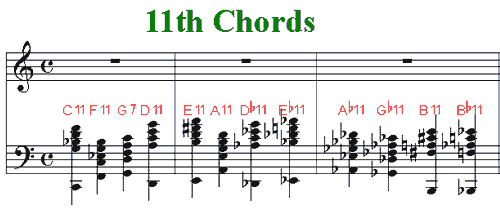
The lowest note in each case is the root of the chord -- even though I have shown them above directly under the chord, be sure to play that note before you play the chord, and use your sustain pedal to "hook the two parts together."
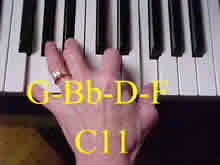 |
 |
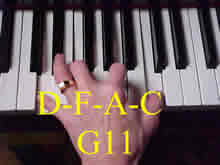 |
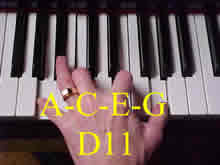 |
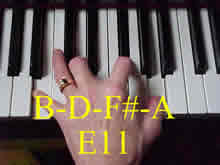 |
 |
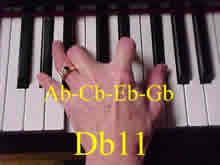 |
 |
 |
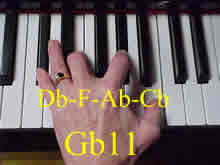 |
 |
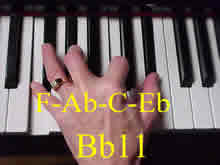 |
Go through all 12 major chords, inverting every one. Then go through all the 12 minor chords, inverting each one up and down the keyboard -- hands alone, then hands together. Then go through all 12 diminished chords, inverting each one up and down the keyboard -- each hand alone, then together. Then play the 12 augmented chords, up and down the keyboard. Then skip around from major to minor to diminished to augmented, etc.
Then add minor 6th chords to your repertoire of chords. They are shown in root position above, but you know that you can turn them upside down 'till the cows come home -- invert them -- so go to it! And then add 7th chords and their inversions....then major 7th chords.....then 9th chords, and now, 11th chords.
Do you feel like you're getting a handle on chords yet? You ought to -- I know we're going slowly, but chords are SO important that you absolutely MUST master them if you are ever going to play the piano like you hope to!
So here's our revised chord scorecard:
12 major and 12 minor chords with 3 inversions
12 diminished and 12 augmented chords with 3 inversions
12 major 6th and 12 minor 6th chords with 4 inversions
12 7th and 12 Maj7 chords with 4 inversions
12 9th and 12 11th chords with 4 inversions*
all of which means you can now play
432 chords!
 In one octave, yet!
In one octave, yet!
Hello!
Are you doing
great, or what?
Next week we will add 12 more chords to our growing list of chords we can play by adding 13th chords to our stash. (Actually 60 more chords, since each 5-note chord such as a 13th can be inverted 5 ways -- root position, 1st inversion, 2nd inversion, 3rd inversion, and 4th inversion!)

